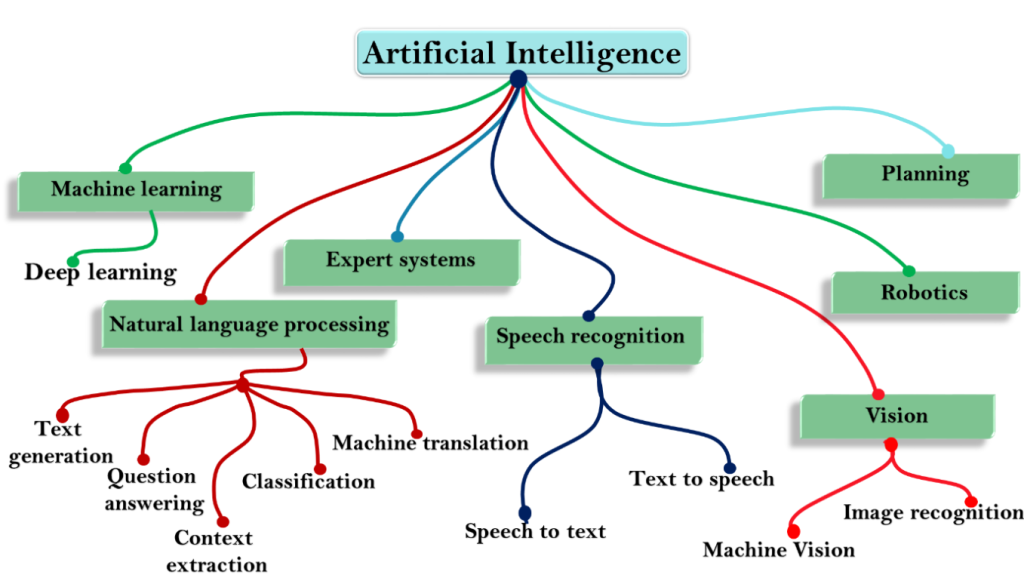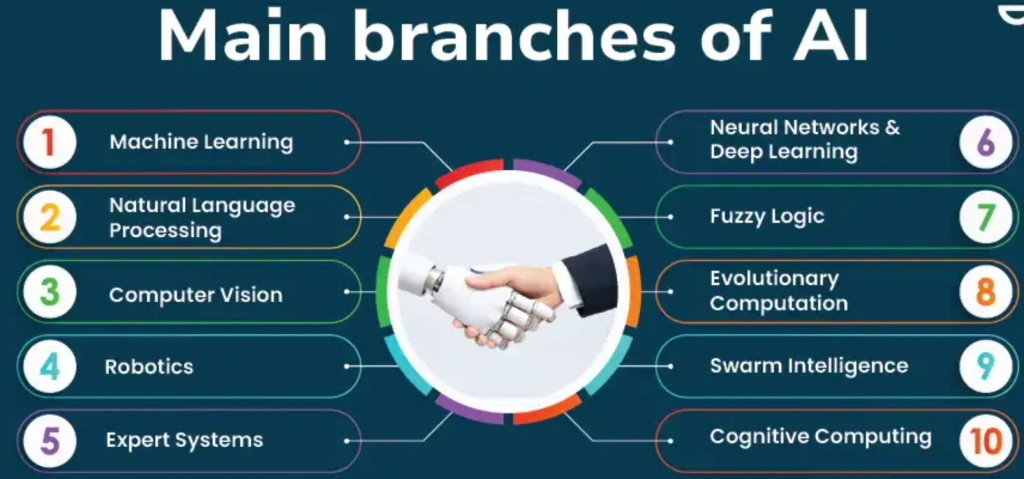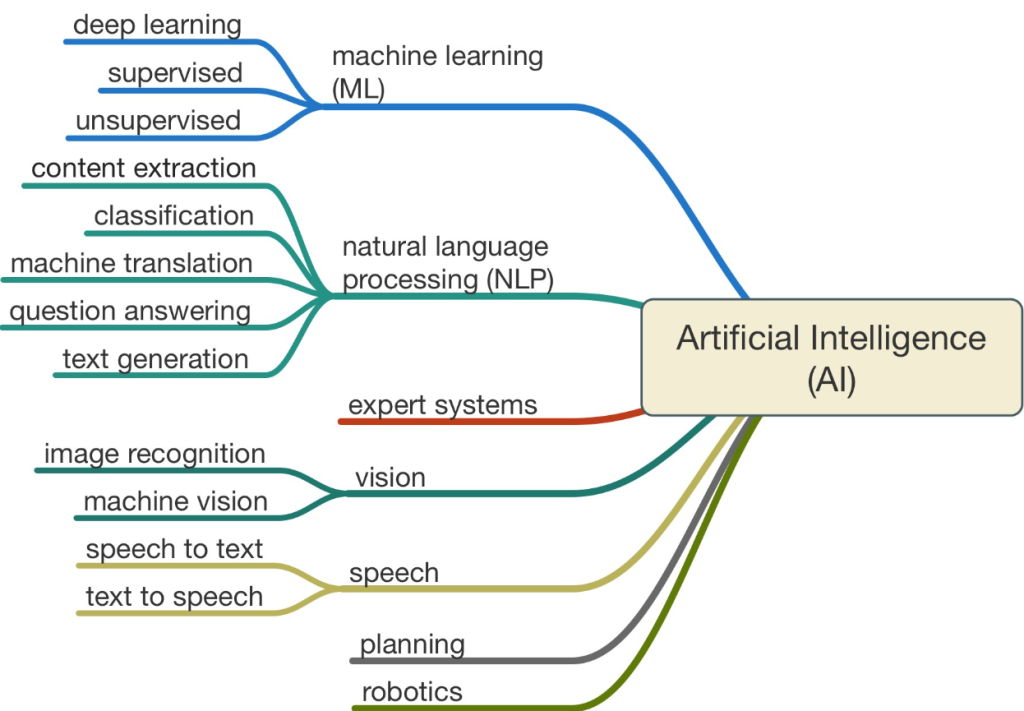The evolution of branches and subbranches of Artificial Intelligence (AI) has been driven by the quest to create intelligent systems capable of performing complex tasks that traditionally required human cognition. Early developments in AI, such as rule-based expert systems and basic machine learning algorithms, laid the groundwork for more sophisticated techniques like neural networks and deep learning. As computational power and data availability have increased, AI has expanded into specialized areas such as natural language processing, computer vision, and robotics, each spawning its own subfields like sentiment analysis, object detection, and autonomous systems. These advancements have been fueled by interdisciplinary research, blending insights from mathematics, neuroscience, linguistics, and engineering, leading to the rich and diverse landscape of AI that continues to grow and adapt to new challenges and applications

1. Machine Learning (ML)
- Supervised Learning: Trains models on labeled data to predict outputs based on input features.
- Classification: Assigns input data to predefined categories.
- Regression: Predicts continuous numerical values from input data.
- Neural Networks: Models complex patterns using interconnected layers of nodes.
- Unsupervised Learning: Identifies hidden patterns in data without labels.
- Clustering: Groups similar data points together.
- Dimensionality Reduction: Reduces the number of input variables to simplify models.
- Anomaly Detection: Identifies outliers or unusual data points.
- Association Rules: Discovers relationships between variables in large datasets.
- Reinforcement Learning: Trains agents to make decisions through rewards and penalties.
- Model-Based: Uses a model of the environment to plan actions.
- Model-Free: Learns actions directly from experience without an explicit model.
- Policy Gradient Methods: Optimizes decision policies directly.
- Q-Learning: Estimates the value of actions to maximize future rewards.
- Semi-Supervised Learning: Combines a small amount of labeled data with a large amount of unlabeled data.
- Self-Supervised Learning: Uses the data itself to generate labels for training.
- Transfer Learning: Applies knowledge from one task to improve performance on another.
- Deep Learning: Uses deep neural networks to model complex data patterns.
- Convolutional Neural Networks (CNNs): Specialized for processing grid-like data such as images.
- Recurrent Neural Networks (RNNs): Processes sequential data by retaining information from previous inputs.
- Long Short-Term Memory Networks (LSTMs): A type of RNN that handles long-term dependencies in sequential data.
- Generative Adversarial Networks (GANs): Pits two neural networks against each other to generate realistic data.
- Autoencoders: Learns efficient representations of data for tasks like compression.
2. Natural Language Processing (NLP)
- Text Analysis: Processes and interprets textual data.
- Sentiment Analysis: Determines the emotional tone of text.
- Named Entity Recognition (NER): Identifies and classifies entities like names and dates in text.
- Part-of-Speech Tagging: Labels words in a text with their grammatical roles.
- Machine Translation: Automatically translates text from one language to another.
- Statistical Machine Translation: Uses statistical models to translate text.
- Neural Machine Translation: Utilizes deep learning models for more accurate translations.
- Speech Recognition: Converts spoken language into text.
- Automatic Speech Recognition (ASR): Transcribes speech into written text automatically.
- Language Modeling: Predicts the likelihood of a sequence of words in a language.
- Chatbots and Conversational AI: Simulates human conversation through text or voice.
- Information Retrieval: Finds relevant information in large datasets, like search engines.
- Text-to-Speech (TTS): Converts written text into spoken language.
- Speech-to-Text (STT): Converts spoken language into text.
- Summarization: Produces concise summaries of longer texts.
- Extractive Summarization: Selects key sentences from the original text.
- Abstractive Summarization: Generates new sentences that convey the main ideas.

3. Computer Vision
- Image Processing: Enhances or manipulates images for analysis.
- Object Detection: Identifies and locates objects within images or videos.
- YOLO (You Only Look Once): A fast object detection algorithm.
- R-CNN (Region-based CNN): A method for detecting objects by selecting region proposals.
- Image Recognition: Classifies objects within images.
- Image Segmentation: Divides an image into meaningful regions or segments.
- Facial Recognition: Identifies individuals by their facial features.
- Optical Character Recognition (OCR): Converts images of text into machine-readable text.
- Motion Analysis: Analyzes movement within video frames.
- Video Tracking: Tracks the movement of objects across video frames.
- 3D Vision: Reconstructs 3D models from 2D images.
- Stereo Vision: Uses two images to estimate depth and 3D structure.
- Structure from Motion (SfM): Creates 3D models by analyzing motion between images.

4. Robotics
- Autonomous Robots: Robots capable of performing tasks without human intervention.
- Swarm Robotics: Coordination of multiple robots to perform tasks collectively.
- Industrial Robotics: Robots used in manufacturing and production settings.
- Human-Robot Interaction: Studies the interactions between humans and robots.
- Assistive Robotics: Robots designed to assist people with disabilities or in daily tasks.
- Robotic Process Automation (RPA): Automates repetitive tasks in software applications.
- Surgical Robotics: Robots that assist in performing surgeries with precision.
- Drone Technology: Unmanned aerial vehicles used for various applications.
- Robotic Perception: Integrates sensors and data analysis for robot awareness.
- Sensor Integration: Combines data from multiple sensors for better perception.
- Computer Vision in Robotics: Applies vision techniques to enhance robot functionality.
5. Expert Systems
- Rule-Based Expert Systems: Uses predefined rules to make decisions.
- Fuzzy Expert Systems: Handles uncertain and imprecise information.
- Neural Expert Systems: Combines neural networks with expert systems for decision-making.
- Bayesian Expert Systems: Uses Bayesian probability to model uncertainty in decision-making.
- Knowledge Engineering: Involves creating knowledge bases for expert systems.
- Inference Engines: Processes rules and knowledge to derive conclusions.
6. Fuzzy Logic
- Fuzzy Control Systems: Uses fuzzy logic to control systems with uncertain data.
- Fuzzy Decision Making: Applies fuzzy logic to make decisions under uncertainty.
- Fuzzy Classification: Classifies data based on fuzzy set theory.
- Fuzzy Pattern Recognition: Identifies patterns using fuzzy logic.
7. Artificial General Intelligence (AGI)
- Universal Learning Systems: Theoretical systems that can learn any intellectual task a human can do.
- Theoretical AGI Models: Conceptual models for achieving human-level intelligence.
- Cognitive Architectures: Frameworks that aim to replicate human cognition.
- Machine Consciousness: Explores the possibility of machines having self-awareness.
8. Neural Networks
- Artificial Neural Networks (ANN): Basic neural networks that mimic the human brain’s structure.
- Convolutional Neural Networks (CNN): Specialized for processing visual data.
- Recurrent Neural Networks (RNN): Designed for sequential data like time series or text.
- Deep Belief Networks (DBN): A type of deep learning network for unsupervised learning.
- Self-Organizing Maps (SOM): Unsupervised networks that visualize high-dimensional data.
- Radial Basis Function Networks (RBFN): Neural networks that use radial basis functions as activation functions.
- Generative Adversarial Networks (GAN): Networks that generate new data by pitting two networks against each other.
- Spiking Neural Networks: Models that simulate the brain’s spiking neuron activity.
9. Genetic Algorithms
- Genetic Programming: Evolves programs or algorithms to solve problems.
- Evolutionary Strategies: Optimizes solutions using mechanisms inspired by biological evolution.
- Differential Evolution: A method for optimizing multi-dimensional functions.
- Particle Swarm Optimization: Uses the behavior of swarms to find optimal solutions.
- Ant Colony Optimization: Simulates the behavior of ants to find optimal paths.
- Simulated Annealing: A probabilistic technique for finding the global minimum of a function.

10. Recommender Systems
- Collaborative Filtering: Recommends items based on user similarity and preferences.
- Content-Based Filtering: Recommends items similar to those a user has liked in the past.
- Hybrid Recommender Systems: Combines collaborative and content-based filtering for better recommendations.
- Context-Aware Recommender Systems: Takes context into account for personalized recommendations.
11. Knowledge Representation and Reasoning
- Ontologies: Formal representations of knowledge as a set of concepts and relationships.
- Semantic Networks: Graph structures that represent relationships between concepts.
- Frames: Data structures for dividing knowledge into substructures by representing “stereotyped situations.”
- Logical Reasoning: Uses logic to derive conclusions from given information.
- Probabilistic Reasoning: Deals with uncertainty by applying probability theory.
- Default Reasoning: Assumes typical scenarios in the absence of specific information.
- Temporal Reasoning: Reasoning about time-dependent information.
12. Swarm Intelligence
- Ant Colony Optimization: Mimics ant behavior to solve optimization problems.
- Particle Swarm Optimization: Simulates the social behavior of birds or fish.
- Bee Colony Optimization: Inspired by the foraging behavior of honeybees.
- Firefly Algorithm: Models the flashing behavior of fireflies for optimization.
- Cuckoo Search: A metaheuristic inspired by the brood parasitism of cuckoo species.
- Fish School Search: Simulates the schooling behavior of fish for optimization tasks.
13. Cognitive Computing
- Cognitive Analytics: Applies AI techniques to understand and interpret data as a human would.
- Natural Language Understanding (NLU): Enables machines to understand human language.
- Question Answering Systems: Automatically answers questions posed by humans.
- Cognitive Robotics: Builds robots that can perform tasks by mimicking human cognition.
- Cognitive Architecture: The design and structure that supports cognitive functions in AI systems.
14. Bayesian Networks
- Dynamic Bayesian Networks: Models sequences of variables that change over time.
- Markov Chains: Models systems that undergo transitions from one state to another on a state space.
- Hidden Markov Models: A statistical model where the system being modeled is assumed to be a Markov process with hidden states.
- Bayesian Inference: Uses Bayes’ theorem to update the probability of a hypothesis as more evidence becomes available.
- Probabilistic Graphical Models: Represents complex distributions with graphs for probabilistic reasoning.
15. Sentiment Analysis
- Aspect-Based Sentiment Analysis: Identifies sentiment towards specific aspects of a product or service.
- Emotion Detection: Recognizes specific emotions from text.
- Sarcasm Detection: Identifies sarcasm in text, which is often challenging due to its subtlety.
- Opinion Mining: Extracts subjective information from text, often related to opinions.
- Polarity Detection: Classifies text as positive, negative, or neutral.
16. Explainable AI (XAI)
- Model Interpretability: Makes AI models understandable to humans.
- Feature Importance: Determines which features most influence the model’s predictions.
- Decision Trees: A transparent model where decisions are made by following a tree structure.
- Local Interpretable Model-Agnostic Explanations (LIME): Explains predictions of any classifier in an interpretable way.
- SHAP (SHapley Additive exPlanations): A method to explain individual predictions based on game theory.
17. Autonomous Systems
- Self-Driving Cars: Vehicles capable of navigating and driving without human input.
- Autonomous Drones: Drones that operate without human control, often used for surveillance or delivery.
- Autonomous Underwater Vehicles (AUVs): Submersible robots used for underwater exploration.
- Mars Rovers: Autonomous robots designed to explore the surface of Mars.
